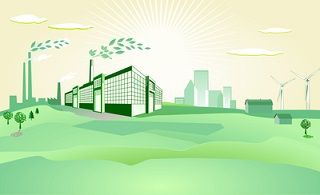From Guest Blogger Ashley: Injection Molding Processes — Which Are Greenest?
As manufacturing companies aim to increase production and reduce costs, analysis of energy consumption within the process is vital. With plastic injection molding, three types of machines and processes are used – hydraulic, hybrid, and all-electric. Any plastics manufacturer may be (and should be) concerned with their impact on the environment. Part of the decision-making toward the goal to be green is figuring out which process and machine to use in order to minimize the negative effects and still be profitable. To do so, one must understand how each system operates.
Hydraulic molding machines operate by pumping a mineral oil-based hydraulic fluid through valves, hoses, pipe and pistons to an electric motor. For any type of hydraulic machine, operators have to ensure the hydraulic fluid is protected from wear and contamination as much as possible. To protect the wear of hydraulic fluid, operators initially used additives such as zinc dialkyldithiophosphate (ZDDP). Now, high performing ash-free additives are available which do not contain metal and are more adhering to environmental standards. Hydrolysis of the fluid can also occur if water is introduced accidentally, causing the chemical breakdown.
Hybrid molding machines typically include hydraulic components in the clamping, injection, and ejection processes and electric screw drive . Hybrid machines’ HP does not decrease when not in use, keeping the injection rate and clamp speed consistent, however consuming more energy. Using these machines lessens production’s impact on the environment, but keeps the same power when compared to all-hydraulic systems.
In all electric molding machines, HP decreases when not in use. This conserves the energy consumption of the machine, however lowers the injection rate compared to the hybrid system. Because they do not require maintenance of hydraulic fluid, valves, or hoses, repeatability of an all-electric machine is what gives them their edge. These machines are also composed of less parts. As we all know, less parts equals less maintenance. This also extends the manufacturer warranties of the machines to the buyer.
A study conducted by Alexandre Thiriez and Timothy Gutowski for the Department of Mechanical Engineering at MIT included running of a generic polymer through all three types of molding machines, hydraulic, hybrid, and all-electric and comparing their SEC, or specific exergy consumed. In thermodynamics, exergy is the maximum useful work during a process which brings the system as a whole at equilibrium with the heat reservoir. They had found that the all-electric machines SEC stays constant as throughput increases. Throughput is the amount of work a computer can do in a given time span. This means lower fixed energy costs (such as computer systems running) for all-electric molding machines than their hydraulic and hybrid counterparts.
While for many years plastics manufacturers have been working with hydraulic machines, energy and upkeep costs with them have lead environmental engineers to look for alternative electrical options to reduce impact on the environment. It clearly is a progression from hydraulic, to hybrid, then to electric. As the manufacturing industry moves toward all-electric solutions, we then must consider the environmental impacts of manufacturing the electrical components of the molding machines themselves. Additionally, the costs of these machines to plastics producing companies will affect what’s being put on the consumers.

